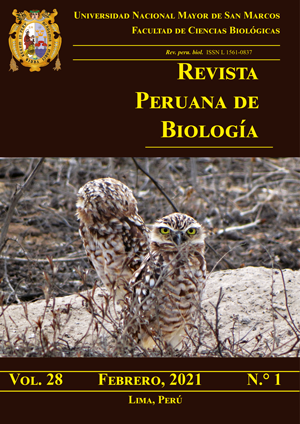Exploratory analysis on wildlife-people conflicts in the Tumbesia La Ceiba Natural Reserve, core area of the Ecuador-Peru Binational Biosphere Reserve "Bosques de Paz"
DOI:
https://doi.org/10.15381/rpb.v28i1.17665Keywords:
Wildlife, Conflicts, Puma concolor, Dry forests, EcuadorAbstract
Conflicts between wildlife and humans are a complex and growing problem, particularly for the conservation of the species involved in the conflict. Despite the existence of studies analysing this issue in the Neotropics, gaps in geographical and/or thematic knowledge about this discipline remain open. Ecuador is home to an important number of studies focused mainly on the identification of species involved in conflicts. However, the country's coast, particularly the southwest dry forests, has remained untouched by this topic. This study was carried out in the communities surrounding the Tumbesia La Ceiba Natural Reserve, Zapotillo canton, in southern Ecuador. Using a semi-structured interview, applied to local inhabitants, we were able to identify, categorize, and define the frequency, causes, and attitudes towards conflicts with the sector's wildlife. Six types of conflicts were identified: hunting, predation of domestic animals, destruction of crops, medicinal uses, species trafficking, and ofidiophobia. Sixteen species are involved in this problem. Puma concolor and Lycalopex sechurae are proposed as the most conflictive species. In addition, an organized community response was identified to address the problems caused by the species; and the costs caused by wildlife attacks were found to be significant, primarily when they involved the loss of goats. This work provides a baseline of knowledge on this issue for the country’s southwest, and shows that the only way to address the problem is to establish public and private partnerships.
Downloads
Downloads
Published
Issue
Section
License
Copyright (c) 2021 Verónica Iñiguez-Gallardo, Alexander Guerrero, Leonardo Ordóñez-Delgado

This work is licensed under a Creative Commons Attribution-NonCommercial-ShareAlike 4.0 International License.
AUTHORS RETAIN THEIR RIGHTS:
a. Authors retain their trade mark rights and patent, and also on any process or procedure described in the article.
b. Authors retain their right to share, copy, distribute, perform and publicly communicate their article (eg, to place their article in an institutional repository or publish it in a book), with an acknowledgment of its initial publication in the Revista Peruana de Biologia.
c. Authors retain theirs right to make a subsequent publication of their work, to use the article or any part thereof (eg a compilation of his papers, lecture notes, thesis, or a book), always indicating its initial publication in the Revista Peruana de Biologia (the originator of the work, journal, volume, number and date).






